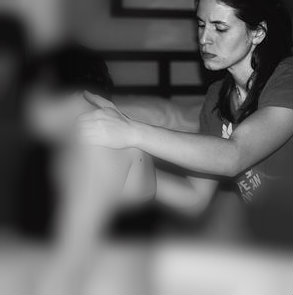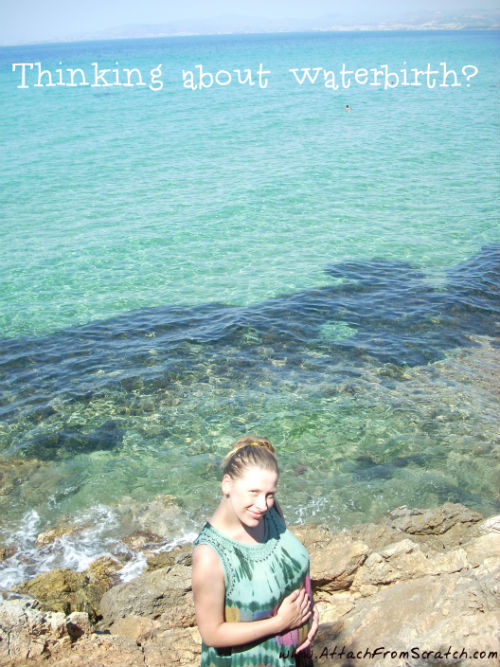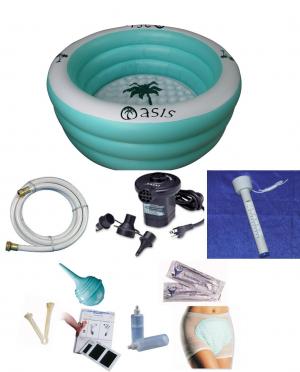Giving Birth In Water
is as good as it gets
Giving birth in water is not a new fashion trend. Mothers have been birthing in water for many many years.
A mother who was in labor for a very long time tried getting in a bath of warm water. This was in France in 1803. The first water birth ever known.
2 centuries later women still give births in water. Joyfully, naturally and drug-free.
If you are thinking about water birth, read this article to get all information you need about natural birth in water.
|
In this article: |
What is Water Birth?
Water birth is miraculous
"The baby has grown in a fluid environment for the past 9 months. Babies adjust very well to being born in a birth pool."
To put in simple words - water birth is a childbirth that happens not on the bed but while mother is in the water.
Some mothers choose to labor in water and get out of it to give birth out of the water. Some stay to give birth in it.
Mothers are giving births in water at the hospitals, at birthing centers and of course at home.
Benefits of giving birth in water
It would be quite hard to find a women who had bad experience with her water birth.
Here is why more and more mothers are giving birth in water:
- It is easier to find a comfortable position during contractions and while pushing
- It speeds up a labor
- It makes it easier to bare with pain
- Less chances to be medicated (for pain or for induction)
- It is easier to relax, because of the water effect and the atmosphere around her with at least intervention as possible
- mother feels more control of her own labor and birthing process.
- Lowers mother’s blood pressure
- More gentle, less shocking and traumatic birth for a baby
- Reduces chances of bigger perinetal tearing
- It’s cheaper.
"Placing a pool of water in a birth room changes the atmosphere immediately.
Voices get softer, the mother stays calmer and everyone becomes less stressed."
Research about water births
|
Study |
Results |
|
1. Does water birth increase the risk of neonatal infection? 1600 waters births. Single institution. 8-year period. |
|
|
2. Maternal and perinatal outcomes amongst low risk women giving birth in water compared to six birth positions on land. Birth center. 12 year period. |
|
|
3. Water births compared with land births. 9 years. This study compares neonatal and maternal morbidity and mortality between water births and land births. |
|
|
4. The aim of this study was to document the practice of water births and compare their outcome and safety with normal vaginal deliveries. Hospital. 5-year period. 301 water births and 301 conventional vaginal deliveries. |
|
|
5. Effects of water birth on maternal and neonatal outcomes. |
|
|
6. Immersion in water in labor and birth. 3146 women |
|
|
7. Water births: A comparative Study with more than 5953 births (over 2000 water births). |
|
Supplies for home water birth
Everybody’s needs and births are unique, the things you might need when you are giving birth in water might be very different, but here are some essential things:
1. Birth Pool. You need one if you are giving birth in water in the hospital and they don’t have one. Or if you are giving birth in water at home and you don’t want to you use your bathtub.
There is a big variety of birth pools out there, so you should look at this criteria on deciding which one is best for you:
Look at this comparison of prices and features of different birth pools.
Before purchasing a birth pool try looking into renting one or borrowing from a friend.
- Width
- Depth
- Visibility (color)
- Portability
- Accessories you would need such as portable or built in stools, pool covers (so the water won’t get cold while mother is out).
2. Drinking water hose. Don’t use your garden hose to fill up your birth pool. Get a drinking water hose which are lead-free and don’t release chemicals when hot water runs through them.
Not many people think of a tap adapter, yet it is a very important little detail if you don’t want to stand there by the kitchen sink and hold the hose to the tap.
3. Electric pump will save your lungs and a lot of time. It’s a must have.
4. Get all the unnecessary floating things out of the water with debris net.
5. Use a tarp to put it under the pool.
Tip
Put a camera on a tripod and leave it on, so everybody can be in action and later can enjoy the stable view that’s actually not the shoes of excited grandmother who forgot that she was filming.
6. Shoulder-length gloves will be useful for the person who will be cleaning the pool afterwards.
7. Waterproof flashlight and a mirror will help you catch the first glance of the baby coming out.
8. Waterproof camera will capture amazing shots.
9. Some waterproof sheets and plastic drop sheets if you need to cover and protect some areas in the house.
10. Chlorhexidine Gluconate Cloths for sanitizing and cleaning the pool.
11. Floating thermometer to monitor the temperature of the water.
|
|
These are just some specific items that you might need when you are giving birth in water. Some things you might have at home already, but if you don’t, it might be a good idea to purchase the whole Water Birth Kit. They are usually cheaper than buying items separately. |
Safety tips for home water birth
If you are considering giving birth in water, please read these basic safety tips.
- Make sure to clean the tub (this isn’t usually your job) with an antiseptic solution, let it air dry and then fill it up with tap water.
It is important for water to be clear, clean and at right temperature all times. If you can drink it - you can give birth in it.
- To create the buoyancy effect and “call” all of those hormones to speed up the labor, mother’s belly should be completely covered with water (up to her breast level). If the immersion is right, mother’s body will respond by releasing more oxytocin, which helps to speed up the labor process.
- Not until mother’s cervix is dilated 4 cm (because early water immersion might stop or slower the labor)
- Whenever mother feels that she wants to go in the water. Some observations were made and they showed that women becomes more relaxed and not as frustrated, which might cause to progress the labour. Observation also had monitored mother’s contractions, which were as intense as they would had been laboring out of the water. The water helps mother to ease the pain so contractions feel lighter even though they are as strong and intense as laying on the bed.
- Keep checking on the temperature of the water.
- Keep room temperature warm, and have plenty of dry towels available.
- Use Doppler to monitor fetal heart.
- Place the baby on your chest as soon as he comes out of water. Encourage breast contact.
Did you know that...
... twins, babies of mothers who had previous c-sections and breech positions can be born in water.
Successful birth in water for 3 both breech and multiples is documented.
Your partner
during water birth

1. Your partner in life is with you to be your Nr. 1 support.
His role is huge when giving birth in water.
Before the birth, do a lot of talking. Getting to know each other's wishes and expectations about the first moments of the baby coming out to this world.
2. Midwife performs actual medical care and delivery.
Certified midwives has an RN and BSN degree, has accreditation (special schooling and apprenticeship). Certified midwife can assist you with your water birth in the hospital and at home.
Non-accredited midwives went through school as well but they are more into natural birthing process. They are not uptight with various regulations. Non-accredited midwife can assist with your natural water birth at home.
3. Doula is there to support the mother and meet her needs. She provides emotional support, education, and offers comfort measures:
|
The doula works with the mother from the waist up and the midwife works with the mother from the waist down. |
When you are searching for a midwife or a doula, look for:
- the one who has the same birthing goals as you have.
- her holistic and spiritual approach to women’s body, a family bond, dietary should be close to yours.
- her care should be women and family centered.
- treats your pregnancy and birth as a normal and natural thing, which requires some support and guidance, but not a surgery or other medical procedure.
- thinks you are a healthy women, not a patient.
|
TIP Especially if your are giving birth in water at the hospital or at the birthing center make sure to talk with your midwife about all the process as there are some rules and regulations they have to follow during water births. For example, hospital’s protocols doesn’t allow birth in water, while laboring in it is ok. |
Risks of water birth
(mostly theoretical)
As a regular ‘on bed’ birth in the hospital has many potential problems and disadvantages, water birth has some too. However, most of them are just theoretical and basically don’t ever happen. But it is important to know both sides.
So here are some of the risks of giving birth in water:
- The blood stream of the mother can receive water and the "theoretical risk of water embolism" can occur.
- Water aspiration can happen when the baby is stressed in the birth canal or the umbilical cord becomes twisted. When water is inhaled and goes to the lungs, death can result.
- As the baby rises to the surface of the water, there is a possibility for the umbilical cord to be removed by accident.
- Labor can be prolonged due to the contractions being relaxed.
- The perineum, found between the vagina and anus, can have more tearing.
- The baby can be infected with bacteria that come from the water.
- The blood loss of the expectant mother is considerable.
Back To Top of Giving Birth in Water
Common questions
about home water birth
Giving birth naturally in water seems easy and common sense, but there some obvious questions parents need answers to.
What prevents baby from inhaling while he is under water?
1. When the baby is born his breathing muscles simply don’t work because of Prostaglandin E2 levels being high.
2. When the baby is born he is going through mild hypoxia and has lack of oxygen which makes the baby swallow, not breath or open his mouth.
3. When the baby is born water cannot pass into his lungs because hypertonic solutions are denser and prevent hypotonic solutions from merging or coming into their presence.
4. When the baby is born he has dive reflex and it goes around the larynx. The larynx is covered all over with taste buds and has 5 times as many as taste buds as the whole surface of the tongue. So, when a solution hits the back of the throat, passing the larynx, the taste buds interprets what element it is and the glottis automatically closes and the solution is then swallowed, not inhaled.
What should be the temperature of water?
The temperature of water should be comfortable for mother. However it should be monitored and do not exceed 100 degrees F. If the water temperature goes above 101 it could raise mother’s body temperature which can cause baby’s heart rate to go up.
Mother should keep drinking enough water and cool herself with towels or some spray on her face.
Giving birth in water. How much does it cost?
US hospitals which offer water births as an birth option, usually don’t charge any extra fees except if they don’t have a permanent birth pool. You may have to pay for renting/using a birth pool yourself.
But check with your insurance company first as some may cover/reimburse the pool rental fees. All you have to say that you had a vaginal birth.
Giving birth in water in my local hospital. Is it possible?
Good news that more and more hospitals are more open-minded about water births.
Bad news. IT is not easy to go through all of those rules, protocols and regulations. There are no national guidelines for water pool births, but hospitals make their own, which may vary. So if your goal of giving birth in water is to be as natural as possible, to have less (or none) medical intervention you might want to consider giving birth in water at home.
So before you decide on giving birth in water in a hospital ask your midwife or a doctor about the guidelines of water birth for a specific hospital.
Other questions to ask when deciding on hospital water birth to find out the competency of the care:
- the number of women who use birth pools during labor every year?
- the number or women who give birth in water every year?
- the number of trained midwives who can assist you in giving birth in water
- what would you be offered in case birth pool is not available
- what are the chances that the water birth pool will be available to you when you need it
After the baby is born how long should he stay under the water?
It is recommended to take the baby within few seconds after he is born. It should be a gentle and slow motion.
Even though placenta is providing baby with oxygen, it cannot be seen or predicted when will placenta start to separate and stop the oxygen flow for the baby.
Take the baby gently out of the water and place him on your chest.
Giving birth in water naturally is the very first best thing you can do for your child... and yourself.
"The whole point of natural birth is the knowledge that a women is the power birth source.
She might need help, but in essence, she always had, currently has, and will always have the power. "
Heather Mccue
Watch this video to visualize the natural home water birth and get some inspiration.
These books will change your whole understanding about water births and its miraculous philosophy.
 |
Book Shelf For Life
by Barbara Harper 2. Water Birth: A Midwife's Perspective by Susana Napierala |
What was your waterbirth like?
Do you have a great story about this? Share it!
Disclaimer
The information on this page is for your education purpose only. It is not intended nor implied to be a substitute for professional medical advice. You should always consult your healthcare provider to determine the appropriateness of the information for your own situation.
Back To Top of Giving Birth in Water
Like This Page?
|
|
Let Google know about it |











